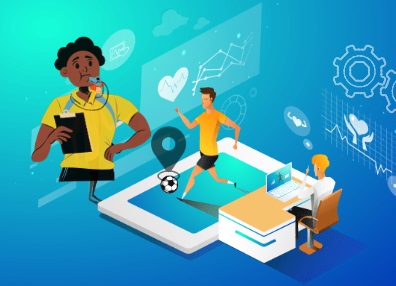Technology in sports has changed how athletes train and compete, how coaches prepare their teams, and how spectators enjoy the events during the last decade. The way sports are played and watched has changed as a result of technological advancements.
Uses of Technology in Sports

Technology in sports allows players to track their performance, coaches to analyze their opponents, and fans to interact with the game in real-time. Through the use of wearable sensors, virtual reality, and data analysis, technology has helped sportspeople improve their performance, coaches develop better plans & techniques, and fans follow their favorite teams more closely. Technology has also enabled new forms of sports to reach a far larger audience, such as drone racing and e-sports. Technology has become an important part of sports, and it is expected to improve and spread more in the near future.
Here we will discuss how technology is used in sports in modern times.
Data collection by technology in sports:
Data collection technology in sports has become increasingly sophisticated in recent years. Common data collection technologies used in sports include motion tracking, accelerometers, heart rate monitors, GPS tracking, digital video analysis, and biomechanical sensors. Motion tracking is used to measure the speed, acceleration, and direction of athletes’ movements on the field or court. Accelerometers measure the force exerted on the body during a particular activity. Heart rate monitors are used to measure the intensity of an athlete’s workout. GPS tracking is used to track an athlete’s location and movement during a game or practice. Digital video analysis is used to analyze an athlete’s performance and technique, and biomechanical sensors measure the body’s muscle and joint movements during a particular activity.
Data Analytics by Technology in Sports:
It is the use of data and statistical analysis to gain insights into the performance of athletes, teams, and leagues. Analytics can be used to measure individual performance and make predictions about future performance. Analytics can also be used to identify patterns and trends in sports and provide insights into how teams and leagues can improve.
Fitness Tracking by Technology in Sports:
Fitness trackers are devices that can measure and track physical activity, such as steps taken, distance traveled and calories burned. This data can be used to monitor an athlete’s performance and give feedback on how to improve. Fitness trackers are increasingly being used by professional athletes and coaches to monitor the progress of athletes and measure their performance.
Augmented Reality used in sports by technology:
Augmented reality is the real-time integration of digital information with the user’s environment. In sports, it is used to provide players and coaches with a better view of the field as well as real-time game analysis. A coach could use augmented reality to evaluate player performance, or a player could use augmented reality to locate the perfect passing place.
Virtual Reality:
Virtual Reality provides athletes with a unique opportunity to hone their skills in a simulated setting. For instance, golfers can practice their swing in a virtual environment, while basketball players can use VR to work on their shooting technique. This technology provides a safe and controlled platform for athletes to perfect their technique and gain confidence before stepping onto the field or court.
Wearable Technology:
Wearable technology is any electronic device or clothing item that can be worn on the body. In sports, wearables can be used to monitor an athlete’s performance and give feedback on how to improve. Wearables can also be used to track the performance of an entire team and provide real-time analysis.
Video Analysis by Technology in Sports:
It is widely used by coaches and organizations to analyze the performance of athletes and teams. Video analysis can be used to identify areas of improvement in an athlete’s performance. And make training and strategic decisions more effectively. Here a coach, as well as an athlete, can find their gaps easily. They get a chance to make a better game plan.

GPS systems in sports:
GPS systems in sports are used to track speed, distance, and the position of athletes on the field. Video analysis software is used to analyze game footage to better understand player movement and strategy. Wearable technology can be used to monitor athlete performance and health, allowing coaches to make adjustments during the game.

Accuracy in Judgment by Technology in Sports:
Previously, judges faced particularly puzzling situations when it came to rendering ultimate judgment in sports. As a result, we saw a wide range of emotions as a result of faulty judgment, from heated debates to public outbursts, from hostile faces on athletes to verbal spats, and so on. However, as technology advances, it has become much easier to minimize these conflicts with increasing measurement accuracy. Nowadays accuracy in judgment is viewed as essential for achieving success in precision sports.
Finally, technology has had a significant impact on the world of sports. It has provided athletes with the ability to perform better and to monitor their performance more accurately. It has also improved the way that fans are able to follow and interact with the games. Technology offers athletes the chance to maximize their performance, boost attendance and revenue, and enhance the experience for all participants.